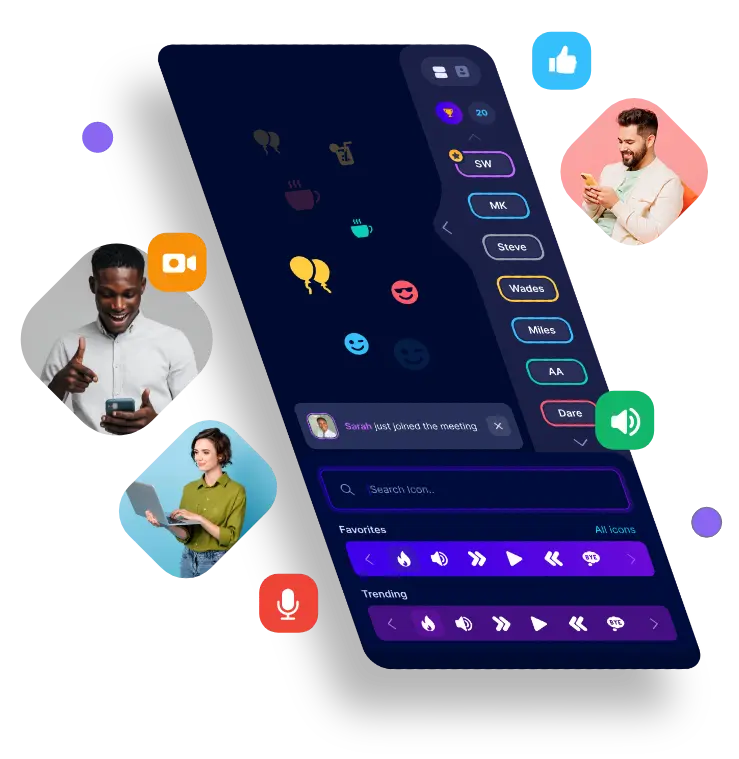
Collaborative learning has become increasingly important in virtual settings, as it allows for the exchange of ideas and knowledge among participants.
Despite challenges like lack of face-to-face interaction, technological issues, and time zone differences, successful collaborative learning in a virtual setting is achievable.
Essential strategies include using online collaboration tools, setting clear expectations, and encouraging active participation.
By following best practices like setting realistic goals, fostering diversity, and offering timely feedback, collaborative learning can flourish in a virtual environment.
What is Collaborative Learning?
Collaborative learning is an educational approach where students actively engage in group activities to achieve shared learning goals.
Through collaborative learning, students have the opportunity to engage in discussions, debates, and projects, fostering critical thinking and problem-solving skills. By interacting with their peers, students can gain diverse perspectives, enhance their communication skills, and develop a deeper understanding of the subject matter.
The principles of collaborative learning emphasize the importance of teamwork, active participation, and shared responsibility among students. By working together towards a common objective, students can enhance their own learning experience while also fostering a sense of community within the classroom.
What are the Benefits of Collaborative Learning?
Collaborative learning offers numerous advantages, including enhanced student engagement, improved problem-solving skills, and a deeper understanding of the material. Read our post on 5 Innovative Strategies to Boost Remote Team Engagement.
When students work together in groups or pairs to achieve a common goal, they are able to share their knowledge, ideas, and experiences, thus fostering a more dynamic learning environment. Through collaboration, students have the opportunity to learn from one another, reinforce their understanding of concepts, and develop critical thinking skills. To learn more about promoting collaborative learning in a virtual setting, visit Emerald.com.
Collaborative learning encourages active participation and communication, leading to increased retention of information and a sense of ownership over the learning process. This interactive approach not only enhances academic performance but also equips students with essential teamwork skills that are valuable in real-world scenarios.
Challenges of Collaborative Learning in a Virtual Setting
Collaborative learning in a virtual setting presents unique challenges, such as limited face-to-face interaction, technological issues, and the need to maintain student engagement in digital environments.
Without the physical presence of classmates, students may struggle to establish meaningful connections and communication channels, hindering the development of trust and teamwork essential for successful collaboration.
Technological hurdles like internet connectivity issues, software compatibility, and lack of technical proficiency can disrupt the flow of virtual collaborative projects, causing frustration and delays in achieving learning objectives.
Creating engaging digital environments that spark interest and active participation is crucial to fostering a vibrant online learning community where students feel motivated to contribute and interact with their peers.
Lack of Face-to-Face Interaction
One of the primary challenges in virtual collaborative learning is the absence of traditional face-to-face interaction, which can hinder spontaneous discussions and personal connections among students.
To address this issue, educators and institutions have started implementing innovative strategies to promote virtual student collaboration and social interaction. Creating engaging virtual environments that mimic the dynamics of physical classrooms is key to fostering effective learning experiences. Utilizing tools like online discussion forums, group projects, virtual team-building activities, and collaborative digital whiteboards can encourage active participation and enhance communication among students.
Read our post on Remote Team Building Activities That Actually Work.
Technological Issues
Technological issues, such as connectivity problems, software compatibility issues, and platform limitations, can disrupt the seamless flow of collaborative learning in virtual environments.
One of the common challenges faced by learners in virtual collaborative settings is dealing with unstable internet connections, leading to inconsistent participation and difficulty in engaging with peers. Compatibility issues between different software applications used for collaborative tasks can hinder the communication process and cause frustration among team members.
To address these challenges, it is crucial to carefully select reliable online tools that offer stable connectivity and seamless integration with various devices and operating systems. By leveraging technology tools that prioritize user experience and compatibility, learners can maximize their collaborative efforts and achieve better outcomes in virtual learning environments.
Time Zone Differences
Time zone differences pose a significant challenge in virtual collaborative learning, requiring careful scheduling and coordination to accommodate diverse student populations across different regions.
One key implication of these variations is the need for educators to adopt flexible teaching strategies that can bridge the gap between students in different time zones. Utilizing asynchronous learning tools, such as pre-recorded lectures or discussion forums, can allow students to participate and engage with the material at their own convenience. Incorporating time zone converters into scheduling tools can help instructors plan activities that cater to the availability of students across the globe. Encouraging students to communicate openly about their time constraints and preferences can also enhance collaboration and ensure equitable participation in group projects.
How to Promote Collaborative Learning in a Virtual Setting?
Promoting collaborative learning in a virtual setting requires leveraging online collaboration tools, creating an interactive virtual classroom environment, and implementing engagement strategies to facilitate student interaction.
Online collaboration tools play a crucial role in fostering communication and teamwork among students. Choosing the right tools such as video conferencing platforms, shared document editors, and virtual whiteboards can greatly enhance virtual collaboration. It is essential to provide clear instructions on how to use these tools effectively to ensure smooth interactions.
Establishing an engaging virtual classroom environment involves incorporating multimedia elements, interactive activities, and breakout rooms to encourage active participation and collaboration. Effective strategies like group projects, peer reviews, and online discussions help in promoting student engagement and collaborative learning.
Use Online Collaboration Tools
Leveraging online collaboration tools like video conferencing platforms, collaborative documents, and interactive whiteboards can facilitate real-time student interaction and seamless communication in virtual learning environments.
Effective utilization of these diverse online collaboration tools is paramount in supporting interactive and engaging student collaboration. Video conferencing platforms break barriers of physical distance, allowing students to participate in discussions, presentations, and virtual group projects as if they were in the same room.
Collaborative documents, such as Google Docs, enable students to collaborate simultaneously on assignments, provide feedback, and engage in peer editing efficiently. Interactive whiteboards offer a dynamic platform for visual learning, where students can brainstorm, solve problems, and share ideas in real time.
Establish Clear Expectations
Setting clear expectations regarding group tasks, communication protocols, and assessment criteria is essential to guide student collaboration, enhance engagement, and achieve desired learning outcomes in virtual collaborative settings.
When students understand their roles within a group project, it reduces confusion and increases overall productivity. Defining communication guidelines helps establish a framework for effective interaction and ensures that all team members are on the same page. Having transparent assessment standards allows students to know exactly what is expected of them and how their work will be evaluated. By establishing these foundational elements, educators create an environment conducive to meaningful collaboration, active participation, and successful learning experiences.
Encourage Active Participation
Encouraging active participation through discussions, group activities, and peer interactions fosters a dynamic learning environment, enhances student motivation, and promotes interactive learning experiences in virtual collaborative setups.
When students actively engage with their peers and instructors in discussions, it creates an environment where ideas are exchanged, perspectives are broadened, and critical thinking is stimulated. By incorporating interactive activities such as group projects and collaborative tasks, students can apply their knowledge practically and develop essential teamwork skills. Utilizing discussion prompts that spark curiosity and encourage diverse viewpoints can ignite meaningful conversations and deepen understanding of the subject matter.
Assign Group Roles and Responsibilities
Assigning specific group roles and responsibilities promotes accountability, encourages teamwork, and streamlines collaborative efforts in virtual learning environments, fostering effective classroom management and student collaboration.
Defining roles not only clarifies each student's responsibilities but also ensures that tasks are distributed equitably among group members, preventing the burden from falling on one individual.
Task delegation based on strengths and preferences maximizes efficiency and allows students to develop a variety of skills.
A well-organized role allocation process sets clear expectations, reduces confusion, and minimizes conflicts in group interactions.
Establishing a collaborative atmosphere where students can openly communicate, provide feedback, and support each other creates a positive learning environment that enhances engagement and mutual respect.
Provide Opportunities for Peer Feedback
Integrating opportunities for peer feedback and peer assessments gives the power to students to evaluate their peers' work, promotes a culture of constructive criticism, and enhances student accountability in collaborative learning environments.
By incorporating peer feedback mechanisms, students not only receive multiple perspectives on their work but also develop critical thinking skills as they analyze and provide feedback on their peers' assignments. This process creates a dynamic learning environment where students learn from each other, leading to a deeper understanding of the subject matter.
Implementing structured peer assessment activities can also help students become more self-regulated learners, as they actively engage in evaluating their own work in comparison to their peers' submissions. This self-assessment process fosters a sense of responsibility and ownership over their learning outcomes.
Cultivating a culture of constructive feedback among students cultivates a supportive and collaborative learning environment. Encouraging students to provide specific, actionable feedback helps them develop communication skills and empathy, essential qualities for effective teamwork and future professional endeavors.
Facilitate Virtual Group Discussions
Facilitating structured virtual group discussions through video conferencing, discussion boards, and online forums enables meaningful student interactions, promotes knowledge sharing, and enhances collaborative learning experiences.
When structuring discussions in virtual settings, it's important to establish clear objectives and guidelines to keep participants focused and engaged. Utilizing communication tools such as messaging apps, shared documents, and collaborative whiteboards can enhance interaction and productivity within the group. Creating engaging online forums with diverse discussion topics, interactive elements, and timely feedback mechanisms can further support effective student interactions and foster a sense of community among participants.
Incorporate Team-building Activities
Incorporating team-building activities such as icebreakers, collaborative projects, and group challenges fosters a sense of community, promotes inclusivity, and enhances engagement in virtual collaborative learning environments.
When students come together to participate in team-building activities, it goes beyond just creating a fun atmosphere; it builds trust and camaraderie among learners. This sense of community helps in breaking down barriers and encourages students to actively collaborate with one another. Moreover, interactive projects provide a platform for students to apply their knowledge in a practical setting, fostering a deeper understanding and appreciation for the subject matter. Engaging in group challenges not only enhances problem-solving skills but also instills a sense of collective responsibility and teamwork.
Foster a Positive Learning Environment
Creating a positive learning environment characterized by mutual respect, open communication, and emotional support nurtures student motivation, enhances social-emotional learning, and fosters a conducive atmosphere for effective collaborative learning in virtual setups.
One of the key strategies to promote respect within a learning community is by encouraging active listening and valuing diverse perspectives. By fostering a culture where every voice is heard and respected, students feel the power to engage authentically with their peers.
- Furthermore, establishing clear guidelines for communication and collaboration helps set expectations and ensures that interactions remain constructive.
- Emphasizing empathy and understanding in online discussions can create a safe space where students feel supported and valued.
Addressing the emotional well-being of students is essential for maintaining a positive learning environment. Providing resources for stress management, promoting self-care practices, and encouraging open dialogue about feelings can help students navigate challenges and build resilience in their educational journey.
Best Practices for Successful Collaborative Learning in a Virtual Setting
Implementing best practices for successful collaborative learning in a virtual setting involves setting realistic goals, fostering diversity and inclusivity, providing timely feedback, and continuously evaluating and improving the collaborative process.
Setting realistic goals in a collaborative online learning environment helps in creating a clear roadmap for the participants, ensuring that all efforts are aligned towards a common objective. It also encourages accountability and motivation among the learners, as they have specific targets to work towards.
Plus goal-setting, promoting diversity and inclusivity plays a significant role in enriching the collaborative experience. Embracing diverse perspectives, backgrounds, and ideas not only enhances creativity and innovation but also fosters a sense of belonging and respect within the virtual learning community.
Set Realistic Goals
Setting realistic and achievable learning goals ensures that collaborative activities align with desired learning outcomes, guiding assessment processes and enhancing the effectiveness of student collaboration in virtual settings.
Clear learning goals provide a roadmap for students, allowing them to focus their efforts and stay motivated. By establishing specific milestones and objectives, instructors help students measure their progress and make adjustments as needed. This approach not only enhances accountability but also fosters a sense of ownership among learners.
Incorporating measurable outcomes enables educators to monitor student performance effectively and provide timely feedback. It also allows for data-driven decision-making, facilitating targeted interventions to address any challenges that may arise during the collaborative learning process.
Encourage Diversity and Inclusivity
Promoting diversity and inclusivity within collaborative learning environments fosters creativity, expands perspectives, and enriches learning outcomes by creating a supportive and inclusive community for all participants.
By embracing a diverse range of backgrounds, experiences, and viewpoints, individuals bring unique insights that can spark innovative ideas and solutions. One effective strategy for cultivating inclusivity is to actively listen to and respect the contributions of others, ensuring that all voices are heard and valued.
Celebrating diverse perspectives not only enriches discussions but also cultivates empathy and understanding among learners. Establishing a sense of belonging and respect within the learning environment is crucial for fostering collaboration, enhancing critical thinking, and promoting a positive educational experience for everyone involved.
Provide Timely Feedback
Delivering timely and constructive feedback to students promotes continuous improvement, enhances peer communication, and deepens student understanding of collaborative tasks and learning processes in virtual collaborative settings.
Constructive feedback creates a cycle of growth by pinpointing areas for enhancement while reinforcing strengths. By utilizing various feedback delivery methods such as individual comments, rubrics, or audio recordings, instructors can cater to diverse learning styles and preferences, ensuring that students grasp the nuances of collaborative work with clarity.
Establishing peer communication channels, like discussion forums or group chats, cultivates a supportive network where students can share insights, ask questions, and offer each other constructive feedback. This interaction not only strengthens collaborative relationships but also fosters a deeper understanding of different perspectives and approaches to collaborative tasks.
Continuously Evaluate and Improve
Regularly evaluating collaborative learning processes, soliciting student feedback, and implementing improvement strategies are essential to enhance educational practices, optimize the learning experience, and drive continuous growth in virtual collaborative learning environments.
To effectively assess learning processes in collaborative settings, educators can utilize a variety of strategies such as formative assessments, peer evaluations, and reflective exercises to gauge the effectiveness of group interactions and individual contributions. Integrating student feedback plays a crucial role in this evaluation process as it provides valuable insights into areas of improvement, strengths, and challenges faced by students during the collaborative tasks. Incorporating this feedback allows educators to tailor their teaching methods, provide additional support where necessary, and foster a more engaging and personalized learning environment.
Frequently Asked Questions
What is the importance of promoting collaborative learning in a virtual setting?
Collaborative learning allows for the sharing of ideas, perspectives, and knowledge among individuals, leading to a deeper understanding of the subject matter and improved problem-solving skills. In a virtual setting, it also helps to build a sense of community and connection among learners, despite physical distance.
How can promoting collaborative learning in a virtual setting benefit learners?
Through collaborative learning, learners can develop important skills such as communication, teamwork, and critical thinking, which are highly valuable in today's job market. It also promotes a more engaging and interactive learning experience, which can lead to higher retention of information.
What are some strategies for promoting collaborative learning in a virtual setting?
Some strategies for promoting collaborative learning in a virtual setting include using online platforms and tools for communication and collaboration, assigning group projects or activities, and incorporating peer feedback and discussions into lessons.
How can educators facilitate collaborative learning in a virtual setting?
Educators can facilitate collaborative learning in a virtual setting by providing clear guidelines and expectations for group work, creating opportunities for interaction and discussion, and monitoring and providing feedback on group dynamics and progress.
How does promoting collaborative learning in a virtual setting promote inclusivity and diversity?
Collaborative learning in a virtual setting allows for the inclusion of diverse perspectives and backgrounds, as learners from different locations and backgrounds can come together to share their ideas and experiences. It also creates a more inclusive learning environment by encouraging active participation from all learners.
How can learners overcome challenges in promoting collaborative learning in a virtual setting?
Some challenges that learners may face in promoting collaborative learning in a virtual setting include time differences, technical difficulties, and communication barriers. To overcome these challenges, learners can establish clear communication channels, set realistic timelines, and address any issues that arise openly and collaboratively.

